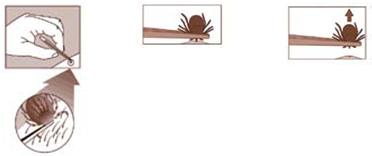So about two and a half hours into our hike I wasn't digging it anymore and we decided to stop, sit on some rocks, reevaluate and try to figure out how to shorten our hike. We figured out that another trail intersected the one we were on and it would cut our hike down. So we continued walking for about another hour before stopping again. Like the previous time, we sat down on a rock, drank some water but this time we noticed deer ticks on our legs (Which is actually something neither of us have ever dealt with before, despite the fact that we go camping every year and frequently visit state parks neither of us has ever had or seen an actual tick before). Justin and I both flicked a couple of ticks off of each of ourselves and then the three of us sprayed ourselves down with bug spray.
Another hour or so later, with another stop (This time Erin and I pulled a "Leave us here to die..." moment with Justin because we both got lightheaded at the same time) and another detour we finally got back to our car. we jumped in, stopped at the nearest store for more water, Powerade and ice pops, and then we drove back home.
As soon as we were back in our apartment Justin and I threw our clothing into the washing machine and jumped in the shower for a tick inspection. That is when I found a tick on the back of Justin's thigh. I had a mini internal freak attack, grabbed a pair of tweezers and pulled that sucker off.
Since dealing with that and becoming slightly paranoid after finding out we are apparently having a bad tick season here on Long Island, I've done some more research on ticks and Lyme Disease and I thought I'd share some of the things that I've read with you guys.
Below is a list of some of the most frequently encountered tick species:
- Deer Tick - Ixodes scapularis (=Ixodes dammini)
- Dog Tick - Dermacentor variabilis
- Lone Star Tick - Amblyomma americanum
- Brown Dog Tick - Rhipicephalus sanguineus
- Wood Tick - Dermacentor andersoni
- Western Blacklegged Tick - Ixodes pacificus
- European Wood Tick - Ixodes ricinus
- Gulf Coast Tick - Amblyomma maculatum
- Winter Tick - Dermacentor albipictus
How Can I Protect Against Ticks & Prevent Lyme Disease?
Deer ticks live in shady, moist areas at ground level. They will cling to tall grass, brush and shrubs, usually no more than 18-24 inches off the ground. They also live in lawns and gardens, especially at the edges of woods and around old stone walls.
Deer ticks cannot jump or fly, and do not drop onto passing people or animals. They get on humans and animals only by direct contact. Once a tick gets on the skin, it generally climbs upward until it reaches a protected area.
In tick-infested areas, your best protection is to avoid contact with soil, leaf litter and vegetation. However, if you garden, hike, camp, hunt, work or otherwise spend time in the outdoors, you can still protect yourself:
- Wear light-colored clothing with a tight weave to spot ticks easily.
- Wear enclosed shoes, long pants and a long-sleeved shirt.
- Tuck pant legs into socks or boots and shirt into pants.
- Check clothes and any exposed skin frequently for ticks while outdoors.
- Consider using insect repellent.
- Stay on cleared, well-traveled trails. Walk in the center of trails. Avoid dense woods and bushy areas.
- Avoid sitting directly on the ground or on stone walls.
- Keep long hair tied back, especially when gardening.
- Bathe or shower as soon as possible after going indoors (preferably within two hours) to wash off and more easily find ticks that may be on you.
- Do a final, full-body tick check at the end of the day (also check children and pets), and remove ticks promptly.
- If you tuck pants into socks and shirts into pants, be aware that ticks will climb upward to hidden areas of the head and neck, so spot-check clothes frequently.
- Clothes can be sprayed with DEET or treated with permethrin. Follow label instructions carefully.
- Upon returning home, clothes can be put in a high temperature dryer for 20 minutes to kill any unseen ticks.
- Any contact with vegetation, even playing in the yard, can result in exposure to ticks. Frequent tick checks should be followed by a whole-body examination and tick removal each night. This is the single most effective method for prevention of Lyme disease.
If you DO find a tick attached to your skin, do not panic. Not all ticks are infected, and your risk of Lyme disease is greatly reduced if the tick is removed within the first 36 hours.
To Remove A Tick:
- Use a pair of pointed tweezers to grasp the tick by the head or mouth parts right where they enter the skin. DO NOT grasp the tick by the body.
- Pull firmly and steadily outward. DO NOT jerk or twist the tick.
- Place the tick in a small container of rubbing alcohol to kill it.
- Clean the bite wound with rubbing alcohol or hydrogen peroxide.
- Monitor the site of the bite for the next 30 days for the appearance of a rash. If you develop a rash or flu-like symptoms, contact your health care provider immediately. Although not routinely recommended, taking antibiotics within three days after a tick bite may be beneficial for some persons. This would apply to deer tick bites that occurred in areas where Lyme disease is common and there is evidence that the tick fed for more than one day. In cases like this you should discuss the possibilities with your doctor or health care provider.
Tick Removal Graphic: CDC/Division of Viral and Rickettsial Diseases
In addition to that here is a video DNews posted about Lyme Disease this past week...
I hope you guys found my little tick PSA informative.




I never worried about ticks until my step-dad got one a couple of years ago and had to actually go to the doctor to get it removed. Ever since then, they totally freak me out. And we don't even really have them around here. He got his in Missouri.
ReplyDeleteTo the doctor?! Ugh.
DeleteI've always had ticks in the back of my mind because they are a thing here on Long Island but honestly as much as I've played in the woods, etc. they've never been a problem before. So it bugged me out having them on myself and Justin.
Eep! Be careful! If there is a bulls-eye looking rash on his thigh where the tick was bring him to a Dr ASAP (I'm sure he's OK though).
ReplyDelete